Almonds
now browsing by tag
Baking with almonds – classic frangipane
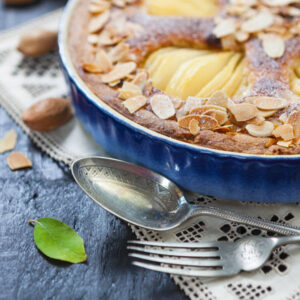
Almonds are not just ideal for gluten-free baking but are also a mainstay of classic patisserie. Here we take a look at the king of the classics; almond frangipane.
What is frangipane?
Frangipane is a classic French pastry cream found in the repertoire of every pastry chef. The main ingredient in frangipane is ground almonds.
Far easier to make than its elegant reputation would suggest, frangipane is simply a mix of almonds, butter, eggs and sugar. Sometimes flour is added to give the mix more stability. It can be mixed with creme patissiere, that other favourite of pastry chefs, to give a soft creamy richness.
How to make frangipane
Frangipane begins with ground almonds. To make your own ground almonds you will need to blanch your almonds. You can put all of the ingredients into a mixer and beat together but the classic way is cream the butter and the sugar first, as you would to make a cake.
Recipe for a classic frangipane almond cream
To fill an 9 inch tart case 250g butter, soft 250g caster sugar 2 egg 2 egg yolk 2 tbsp plain flour 250g ground almonds 1 tsp vanilla paste
-
Cream the butter and sugar together until pale and fluffy. An electric hand mixer is the ideal tool for the job.
-
Beat the eggs and yolks together and beat into the sugar mixture with the vanilla paste.
-
Lightly fold in the ground almonds and the flour.
Make a frangipane tart
The easiest way to make a foolproof frangipane tart is to use tinned fruit. Go for the kind in halves; pears, peaches or apricots.
To line a 9 inch flan tin you will need 300g of shortcrust pastry. The pastry will be cooked along with the almond filling, not blind baked.
Line the tart case and put it the fridge to chill. Pre heat the oven to 190C.
Fill the tart case with the almond filling to just over halfway. Drain the fruit and dry on a paper towel. Press the fruit halves into the filling, creating a circle around the edge. Fill in the gaps at the centre.
Bake in the centre of the oven for about 1 hour, or until the filling is set. It should be golden and well risen. Like cake, a knife inserted into the centre will come out clean.
Once the tart has cooled slightly brush with an apricot glaze made from 2 tablespoons apricot jam brought to the boil with a scant tablespoon of water. Scatter with flaked almonds and cool before slicing into portions. It is best served only just warm.
How to tell if frangipane is cooked
Frangipane is fairly forgiving but like most things it does have a perfect point. It should rise in the oven and form a golden brown crust, with a just set centre. The main cause of undercooked frangipane is baking at too high a heat. The crust will brown too quickly, leaving a soggy centre. Overcooked and it will be dry and granular. As long as it has risen and browned slowly, and you are near the end of the cooking time. you are safe to insert a knife into the filling at the centre. It should come out clean.
What to do with leftover frangipane

There are many things you can do with leftover frangipane but the most obvious, and utterly delicious, is to make almond croissants. Designed entirely for the purpose of using up leftovers, the almond croissant is made by cutting a (preferably stale) croissant through the centre and spreading with frangipane. You only want a thin layer or the croissant will over brown before the frangipane is cooked. Close it up and bake in the oven until the frangipane is cooked through. Scatter with toasted flaked almonds and a liberal snowstorm of icing sugar. Serve warm, tepid even, not hot.
You can freeze almond pastry cream for several months. Bring it up to room temperature before you use it and give it a good stir as it will separate out a bit.
We hope you have been inspired to try your hand at some classic baking techniques.
All of our Australian almonds are pesticide-free. Did you know it is far more cost effective to buy almonds in bulk?
This article was reproduced on this site only with permission from operafoods.com.au the “Gourmet Online Wholesale Grocer”. See original article:- Baking with Almonds Classic Frangipane.
How to make almond milk at home
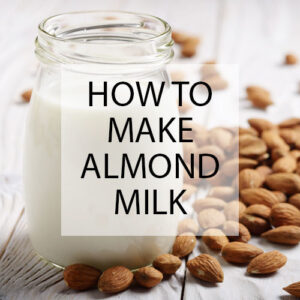
In order to add body and frothing capabilities to commercial almond milk, manufacturers often add various fillers and additives.
Learning how to make almond milk at home gives you total control over the ingredients used. The result will be naturally thick and creamy almond milk.
How is almond milk made in a factory?
Most commercial almond milk is made from Californian almonds. There, the demand is high and the supply unsustainable. A process causing damage to an already fragile ecosystem. Almond milk has been around for centuries but the process came under mass commercialisation just over a decade ago, putting wildlife under threat and endangering the honeybee.
Most industrially produced almond milk contains around 2% almonds. This results in a thin flavourless liquid, which is why so many cartons of almond milk come with a long list of ingredients. Added to provide body and flavour, these extra ingredients may be naturally derived yet are still additives nonetheless.
How to make almond milk at home
To make almond milk you will need fresh, whole, almonds and water. Go for filtered water if that is what you would normally drink at home. You will also need a blender, a sieve, and a clean tea towel or cloth. And a bowl large enough to sit the sieve in.
You may wish to add flavour to your almond milk with a little cinnamon or vanilla. A word to the wise – do try homemade almond milk once before deciding it needs flavouring. Almonds are naturally creamy so the stuff you make is way different to the store bought variety.
The best way to avoid sustainability issues around your almond consumption is to buy local. We wrote all about sustainable Australian almonds and how they are produced, right here.
To make roughly 1 litre of creamy almond milk you will need 1 cup almonds and 4 cups water. You can adjust the ratio of almonds to water depending on how thick you want the result to be. Remember that we said there is about 2% almonds in commercial almond milk? Using 4 cups of water brings that percentage up to 25%, so you can imagine the difference.
Blitz the almonds with the water for about 3 minutes or until the almonds are completely blended. Place the sieve over the bowl, and line with the cloth. Pour in the blitzed liquid and leave to strain until the residue is almost dry. You can give it a helping hand by squeezing the cloth as if you are wringing out a dishtowel. Which, strictly speaking, you are. Pour the resulting almond milk into a container and keep in the fridge for up to 4 days.
Don’t waste the strained nutritious fibre remaining. Sprinkle it on your granola or add it to a Chinese recipe. You can even use almond pulp to make almond meal.
Why not save money and buy almonds in bulk or check out the rest of our wholefoods bulk groceries at our wholesale store
All about Australian almonds
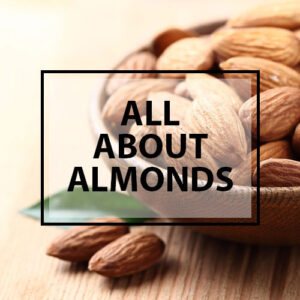
Australian almonds are awesome in so many ways that it can be difficult to know where to start.
So, in our ultimate guide to all things almond we begin with the basics. We look at where, and how, they grow. We also look at the many ways that almonds can benefit your health.
Finally, we have some ideas on what you can do with your Australian almonds once you get them home.
Where do almonds come from?
Also known as sweet almonds, almonds are the edible seed of a stone fruit related to peach and apricot. Originally from Asia, almonds grow in many parts of the Mediterranean, California, and right here in Australia. In fact, did you know that they are one of Australia’s most important crops? They boost our economy, our communities and our way of life.
There are over 15 million almond trees across Australia, mostly concentrated in the Riverina region, Sunraysia, and the Riverland plains of Northern Adelaide. A beautiful sight.
How do almonds grow?
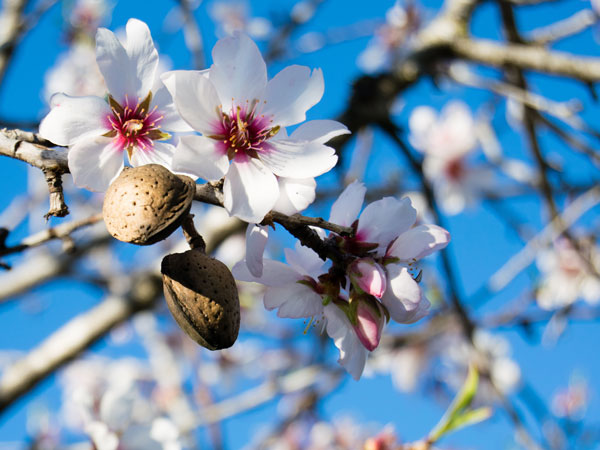
Almond trees are blessed with that rare ethereal beauty of all blossoming trees. Grown in orchards, the buds first appear in winter and blossoms burst into life around July. In full bloom by late winter, the almond blossom is ready for pollination by bees. A perfect example of nature working in tandem, beekeepers place their hives in the orchards ready for pollination season. The trees benefit, and the byproduct of this is fresh floral scented honey. A win win.
The tiny green nutlets appear in spring and develop through the summer. Once developed, but before they split open, these are known as green almonds. Eaten as whole fruits, the green outside flesh can be somewhat bitter, but the young undeveloped almond kernel inside is pale, soft and creamy. By midsummer, the fruits open and expose the seed inside. This is the husk of the almond, within which lies the kernel.
Once split open, the nut itself begins to dry. The fruits are ready for harvest once the stem weakens and the fruit comes easily from the tree. Harvested between February and April, the almond fruits (known as drupes) are shaken from the trees. Left to dry on the orchard floor for about two weeks, they are then picked up and sent to the huller. The almonds are first hulled. Some are shelled whilst others are sold with the shell on. Some are processed further into blanched, slivered or chopped almonds. Or ground into almond meal or flour.
Should almonds be organic?
Because organic certification is an expensive and lengthy process that is not always of benefit to the farmers or the consumer, the questions here should be about sustainability and the use of pesticides. Big brand organic is not always what we expect it to be, as it often has only the bare minimum of legislative requirements met.
However, minimal intervention is something that we can all get behind. It is open to, and achievable by, the smallest of farms, and encompasses the true visions of what organic is all about. With a focus on food quality, environmental impact, and good husbandry, minimal intervention farming is free from harmful pesticides and damaging practices. An holistic approach to farming, it considers every impact at each step of the supply chain.
Are almonds good for you?
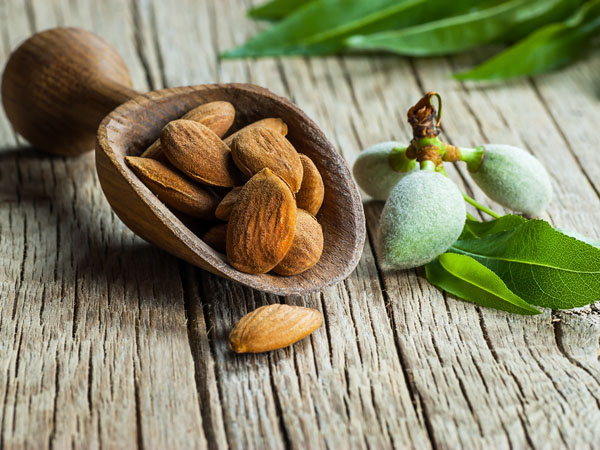
Australian almonds are a bonafide superfood and come with a host of nutritional benefits. Nuts have some of the highest antioxidant levels among plant foods and are also rich in fibre, healthy fats, plus other vitamins and minerals. There are roughly 20 almonds in a serving, which is equivalent to one quarter of a cup or 1 ounce. That’s a very small handful.
The health benefits of Australian almonds
Almonds are a good source of essential minerals zinc, magnesium and potassium. They are also rich in antioxidant Vitamin E that provides support for the tissues of the heart, brain and lungs. Monounsaturated fatty acids found in almonds can help to balance cholesterol levels.
A portion of almonds is made up of 13% carbohydrate, 13% protein and 74% healthy fats as well as a whole host of beauty boosting nutrients. Magnesium and potassium help to beat the bloat, whilst Vitamin E, biotin, and sebum regulating Vitamin B2 all help promote healthy hair, skin and nails.
Are roasted almonds as good as raw?
Whilst raw almonds have a certain creamy quality, a roasted almonds have a depth of flavour and a definite crunch. The water content of raw nuts is lost slightly through the roasting process so they become slightly more concentrated. The nutrient content remains the same, yet volatile antioxidants such as Vitamin E can be lost with the heat of roasting. If you prefer to eat roasted almonds, roasting them yourself means you can cook at lower temperatures and control the amount of oil and salt added.
Blanched almonds have the skin removed and are used in recipes where the brown skin would change the look or the taste of the dish. Most desserts and baking use blanched almonds instead of whole. The skin of almonds does have health benefits however, as it contains nutrients and increases fibre content.
What are activated almonds?
Activated almonds are soaked in salted water for anywhere between 7 and 24 hours. They are then dried slowly in a cool oven. The soaking process encourages germination and therefore increases the nutrient value, as well as breaking down phytic acid which can inhibit mineral absorption.
Is almond meal the same as almond flour?
Almond meal is made from raw, unpeeled almonds whilst almond flour is made from blanched almonds. Almond flour is finer and lighter in colour than almond meal so is more suited to lighter cakes and pastry.
Ground almonds are the same thing as almond flour. At some point during the rise of gluten free baking the name simply changed.
What can you do with almonds?
-
You can make your own almond butter.
-
You can make your own almond milk.
-
You can make your own almond meal.
-
You can blanch almonds.
-
You can make delicious roasted almonds.
-
You can toast them.
-
You can caramelise them.
-
You can bake with frangipane.
-
You can make almond brittle.
Or you can of course just eat them.
Check out our pesticide free Australian raw almonds, or buy in bulk online at our wholesale grocery store
What are the Benefits of Eating Soaked Almonds over Raw Almonds?
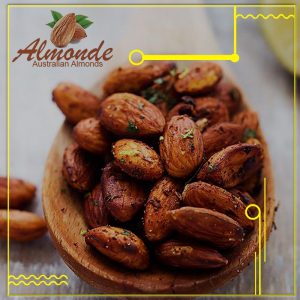
Almonds are known as the best source of Vitamin E all over the world. Almonds are highly nutritious because they contain fiber, protein and a number of essential Vitamins and Minerals. There is a number of amazing health benefits like they protect our skin, helps in the control of sugar levels of blood, and it also strengthens the bones in our body.
The most common question which arises in our mind is “What are the benefits of Eating Soaked almonds over raw almonds?”
Take a handful of almonds and soak them in half cup of water and leave them overnight. When we soak almonds in the water it gets rid of the tannin’s in the skin which will inhibit the nutrients in the almonds to be absorbed by our body. It also softens the almonds and can be easily chewed. You can eat up to ten almonds in the morning and ten almonds in the evening to keep your heart healthy, increase good cholesterol, prevents ageing and inflammation.
Buy them online from Sydney & Melbourne Wholesalers Opera Foods.

 D5 Creation
D5 Creation